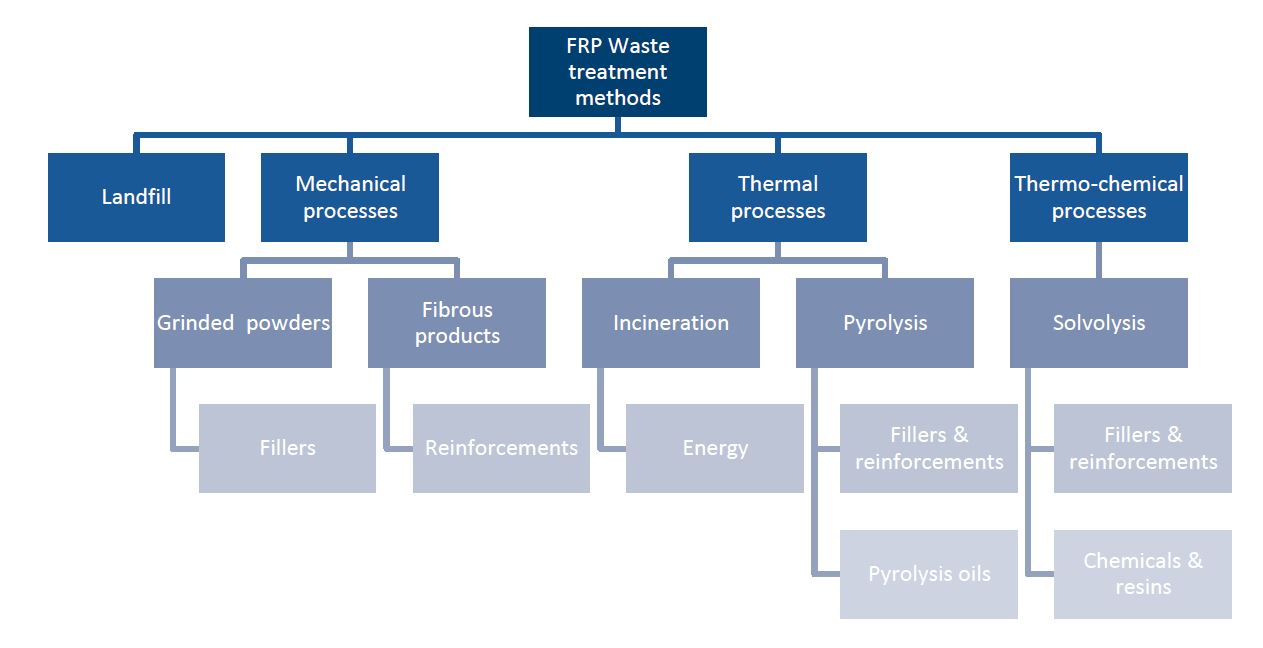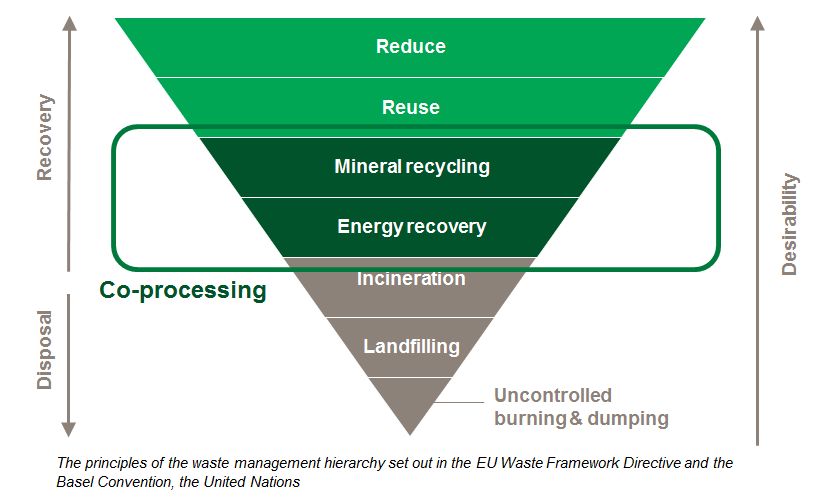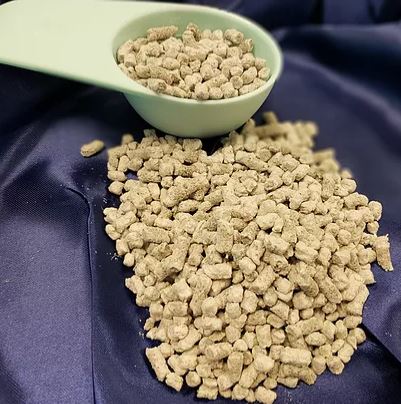One of the future challenges of wind energy is to find a solution to recycle old blades from decommissioned wind turbines. In this post I will try to summarize several possible alternatives and to describe in detail what I think is currently the best option: to use them as a component for the production of cement.
The development of this interesting technical solution started in 2005 when one of the largest wind turbine manufacturer asked LafargeHolcim (a global cement producer) to use the decommissioned blades in cement production plants.
In 2008 Geocycle (the business unit of LafargeHolcim specialized in use of waste to produce cement) launched the full scale development of the solution in the Lägerdorf cement plant, in Northern Germany.
The recycling start in the wind farm, where the blades are cut in 10 meters long pieces using a mobile cutting technique that reduce the generation of fine dust humidifying the area. The resulting water is collected and brought to the recycling plant together with the other materials.
The pieces are then transported by train or truck to a pre-processing plant.
Here the blades are cut before in segments with a length around 1 meter and subsequently shredded in smaller pieces, with a final length of some millimetres.
Metals, both ferrous and not ferrous, are separated automatically from the material flow by magnet and eddy current magnet devices.
Finally, the crushed blade dust is mixed with a humid substrate material made of other residues such as plastic labels and miscellaneous packaging materials. The purpose of this substrate is to homogenize and bind together the blade dust. The material composing the substrate are wastes from other processes such as paper recycling.
All process steps in the pre-treatment plant are fully automated and performed in a controlled atmosphere. This guarantee maximum levels of occupational health and safety.
The end product is put in the cement plant.
In the pre-calciner (an element of the cement plant that optimize fuel consumption) the resin matrix is used as an alternative fuel, substituting coal, petroleum coke, heavy fuel oil or natural gas.
At a temperature around 900 °C the resin burn transforming the blade fibers into ashes. These ashes are then going together with the rest of the calcinated raw materials – usually a mixture of limestone and clay – in the sintering zone of the cement kiln to produce the clinker.
Finally the clinker is ground into a fine powder together with a small amount of gypsum creating the final product, cement.
The cement produced using wind turbine blades is indistinguishable in terms of quality from the standard product obtained without using the blades. It can be sold in the market or used again in wind farms, for instance in wind turbines foundations, closing the loop.
This solution provide alternative raw materials for cement production, reducing the need for quarrying, stone crushing and transportation. The ash of a wind turbine blade consists mainly of silica (SiO2) and calcium oxide (CaO) and due to this substantial amounts of natural resources like carbonate rock (limestone) and clay (usually in the form of sand) can be saved.
Additionally, it has to be noted that this solution contribute to savings of fossil fuel: the resin of the blade provide energy (around 12 MJ/Kg). This value is approximately the half of hard coal: therefore each tonne of rotor blade substitute around half a tonne of hard coal.
It’s important to note that this solution has been indicated in 2011 as the best option available in a Position Paper subscribed by the European Composites Industry Association and other relevant category associations.
The test phase was successfully concluded in 2009 and the solution has been made commercially available since 2010.
I see several interesting benefits associated with this technique:
- It is capable of dealing with large amounts of materials, since the cement plants can handle thousands of tons of material.
- It address as much as possible geographically local opportunities, because it’s operated by LafargeHolcim, a multinational company active worldwide with over 2000 operation sites.
- It is feasible right now, because it is a commercially mature solution currently used in Germany and neighbouring countries. Hundreds of blades have already been recycled.
- It is cost-effective, because is the second cheapest alternative after landfilling.
- It address the totality of the materials of the blades, because the resin matrix is used as combustible, the fibres become part of the cement and other elements (e.g. metallic components) are separated upfront in the pre-processing unit.
- It follow strict environmental and safety standards. This solution has been developed in Germany (one of the first country to ban the landfill of wind turbines blades) and it has been certified by third party bodies.
The final cost is function of several parameters, such as the number of blades to be recycled, the distance of the wind farm from the nearest cement plant and the need to adapt the pre-processing facility.
Therefore, final cost will depend on scale factors, logistic costs and pre-treatment costs.
There are several other alternative. I will try to summarize them in the next paragraphs.
Landfill: Blades are sectioned into pieces of suitable dimensions and placed in a landfill. Transportation and preliminary shredding is needed.
Here no material recovery is possible and some national and local legislation impose high landfill taxes or complete bans on composites material with high organic percentage such as the blades.
Additionally, legislation worldwide is expected to become stricter acting as a driver for the development of alternative solutions and the creation of a recycling market, either with an extended ban or with a sharp price increase for landfill of blades.
Mechanical processes: Blades are reduced in size and separate into powder and fibrous fractions via cutting, crushing, shredding, grinding, or milling processes.
Finer pieces are sorted and used as fillers or reinforcements or as fuel for thermal waste processes.
This is currently done on a limited commercial scale and theoretically it has a wide range of potential applications for material recovery.
However, from an economical point of view it is competing with the lower market cost of alternative virgin fillers (calcium carbonate, silica).
Additionally, it has been observed a reduction of the mechanical properties of the resulting material (lower stiffness and strength). For instance, concrete made using shredded blades instead of crushed stones has unsatisfactory mechanical properties.
The only viable mechanical process currently operating in the market, presented as the competitor solution, is the one offered by Global Fiberglass Solutions, detailed in the following paragraph.
Mechanical processes – Global Fiberglass Solutions (GFS) pellets: The blades are transformed into small pellets that are sold under the brand name of “EcoPoly Pellets”. They are usable in injection mold and extrusion manufacturing processes and they are made from a customized blend of wind turbine blade materials.
EcoPoly Pellets are made to order for final customers based on the requirements of the customer’s own manufacturing process. GFS has initiated distribution options for pellet and has already found several wind farmers owner willing to provide decommissioned blades as input material for pellet production.
I believe that this technique it is currently available only in the USA.
Thermal processes – incineration: Blade sections are incinerated at high temperatures – usually over 800 °C.
Organic substances are combusted and converted into non-combustible material (ash), flue gas and energy. This process is usually combined with energy production and heat recovery.
The ash could also be used as a substitute for aggregate in other applications recovering the material or landfilled. However, no economically viable uses have been found for the ashes (beside the proposed use as input for cement production).
The advantage is that there are already numerous incineration plants available and that it can be done at attractive prices.
The disadvantage is that no large parts can be incinerated, making necessary a preliminary shredding.
Additionally, blades have a high ash content (around 50% to 65%) that needs to be landfilled afterwards with the associated transport and landfill tax costs.
Finally, burning blades create residues that can cause problems in the gas filtering systems.
For all these reasons this solution has been discarded.
Thermal processes – Pyrolysis: Blades are sectioned into suitable dimensions and decomposed using heating ovens in an inert atmosphere (450-700 °C).
Material is recovered in the form of fibres which can be reused in other industries. For instance, in pilot tests they have been used for glues, paints and concrete. Other products of this process include syngas (that can later be combusted for electricity and heat recovery) and char (recycled as fertilizer)
Under certain boundary conditions the resin matrix can be transformed in an oil “Pyrolysis Oil”.
The problem with this technique is that significant amount of energy are needed to activate the pyrolysis, impacting the overall environmental value of the solution.
Furthermore, available laboratory tests show a degradation of the properties of the glass fibers and no secondary market has been found.
Additionally, test have been performed only at laboratory scale so it is considered a solution with a low technological maturity.
Thermochemical processes – Solvolysis: Chemical solvents (water, alcohol, acid) are used to break the resin matrix bonds at elevated temperatures (300-650 °C) and pressures conditions.
Among all the solvents currently tested, water appears as the most commonly used. In this case the process is called hydrolysis.
Fibre materials recovered have a similar strength and could be reused in other applications. The resins as well can be separated and combusted for energy recovery
As far as I am aware test have been performed only at laboratory scale, mainly with focus on carbon fibres composites.
Moreover, due to the low market price of glass fiber, no secondary market is existing.



Leave a Reply